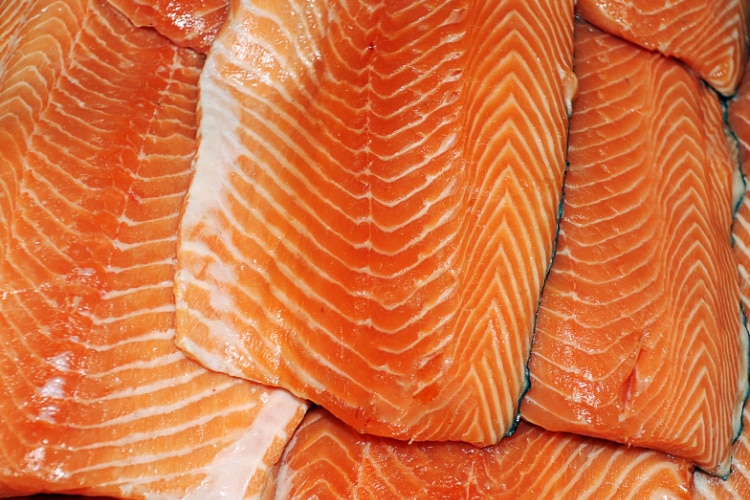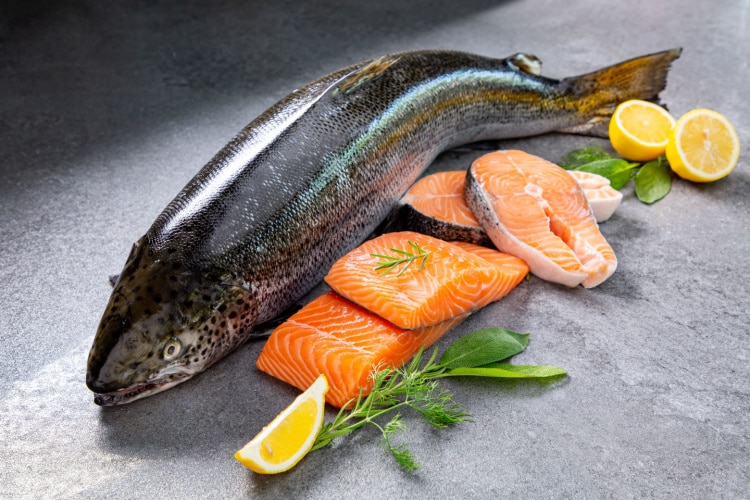Today, we will tell the tale of two salmon species, the Atlantic and Pacific, whose respective waters serve as their kingdoms.
These fish appear similar, but they differ in more ways than the location of their natural habitat. The differences between Atlantic and Pacific salmon go beyond what you may imagine, ranging from lifespans to genus type.
Intrigued? Fantastic! Let’s “dive” into the remarkable world of salmon!
Difference Between Pacific Salmon and Atlantic Salmon
The main difference between the two salmon species is their habitat and size. Pacific salmon is smaller and comes from the Pacific Ocean, while the Atlantic Salmon is bigger and comes from the Atlantic Ocean.

Pacific and Atlantic salmon are members of the Salmonidae family, and surprisingly, this is the only thing that unites both species. Their genus, for instance, is entirely different. The Pacific salmon belongs to the Oncorhynchus genus, while the Atlantic salmon belongs to the Salmo genus.

Additionally, seven different species are classified as Pacific salmon. Five of them — the Chum, Chinook, Sockeye, Coho, and Pink — live in North American waters. The remaining two can be found exclusively in Asian waters: Masu and Amago.
On the other hand, there’s just one species of Atlantic salmon, and it’s known as just that – Atlantic salmon. Let’s continue exploring.
Pacific Salmon Has a Shorter Life Span Than Atlantic Salmon
The Pacific salmon life cycle varies from species to species, lasting anywhere from 1 to 6 years and with a maximum lifespan reaching up to 10 years. The life cycle of Atlantic salmon is 5 to 8 years, with the maximum recorded lifespan being 13 years.
Both species are born in freshwater environments and spend some time there before migrating into the ocean, where they reach full maturity.
Once matured, both Pacific and Atlantic salmon return to fresh waters to breed. These fish know exactly where their hatching home is, so they follow their instinct to return there.
To reach their home, they must swim up to 30 to 50 kilometers against the current each day while overcoming many challenges, including predators. But once there, it’s spawning time!
Most people believe that when salmon is done breeding, they die. However, this is only true for Pacific salmon species.
Pacific salmon spend all their energy in fresh waters to arrive at their breeding place, lay eggs, and dig their nest. Meanwhile, they also stop feeding. Because of this, Pacific salmon lacks the stamina to return to the ocean and sadly dies.
On the other hand, Atlantic salmon are more resilient and can recover, allowing them to return to the sea and restart the cycle the following season.
Atlantic Salmon Is Usually Farm-Raised, but Pacific Salmon Is Always Wild-Caught
Farm-raised salmon spend their whole lives in confined enclosures like saltwater bays and estuaries. On the other hand, wild-caught salmon reside in the open ocean and freshwaters.
As a result, much of the Atlantic salmon species you see in supermarkets and enjoy in restaurants is farm-raised. On the other hand, Pacific salmon is almost always wild-caught.
Pacific and Atlantic Salmon Grow Different Attributes When Dwelling in Freshwater
In the ocean, both Atlantic and Pacific salmon have beautiful, silver color scales, making them very similar. But as soon as they go into freshwater, they begin to develop unique attributes.
Pacific and Atlantic salmon gradually get darker as they get closer to their hatching location, changing to a brown, red, green, or occasionally even a blackish tint. The majority of salmon species’ males also evolve humped backs, larger teeth, and hooked lower jaws.
More specifically, the Pacific Chinook has an emerald sheen and a dark gray back, but in freshwaters, its body gets darker, while its belly and fins get a crimson tint. Adult spawning males have larger teeth, and their snouts grow into hooks.
Another Pacific species, the Chum salmon, is metallic blue and silver, with occasional speckling on the back. Freshwater Chums have dark horizontal stripes running down their sides, with an ombre pattern of green, red, and gray. The males also develop sharp teeth.
On the other hand, the back of the Atlantic salmon in ocean waters is silver with brown, green, or blue undertones. When the Atlantic salmon enters fresh waters, its color changes to deep bronze with reddish dots around the head and body.
Pacific and Atlantic Salmon Have Different Sizes
Both salmon species have a range of sizes, from relatively modest to fairly large.
The largest salmon in the Pacific is the Chinook. It’s 58″ long and weighs 126 lb. The pink variety is the smallest, with around 30″ in length and 7 to 12lb in weight.
The biggest Atlantic salmon ever recorded was 60″ long and weighed over 105lb. Today’s Atlantic salmon typically range in size from 28 to 32” and weigh from 7 to 12lb.
The Taste and Texture Difference Is Minimal
The flavor and texture of salmon from the Pacific and the Atlantic Oceans are similar, almost unnoticeable.
It’s thought that Atlantic salmon has firmer meat and a considerably milder flavor than Pacific salmon. Pacific salmon generally has smaller, more tender flakes, whereas Atlantic salmon has relatively big, chewy flakes.
If there are any distinctions in flavor or quality, it will boil down to personal preferences. However, since the flavor difference is so small, it will be challenging to tell them apart, especially when serving them raw in dishes like sushi, sashimi, or nigiri.
Pacific and Atlantic Salmon Filets Have Different Colors
The salmon meat may be lighter or darker, depending on its fat percentage. Pacific salmon has lean meat with a darker red color. On the other hand, Atlantic salmon is a more fatty filet, and thus this meat is a lighter red color.
Pacific Salmon vs Atlantic Salmon Comparison Table
| Category | Pacific Salmon | Atlantic Salmon |
| Habitat | Pacific ocean | Atlantic ocean |
| Family | Salmonidae | Salmonidae family |
| Genus | Oncorhynchus | Salmo |
| Types | In North American waters: Chinook, Coho, Chum, Sockeye, and Pink salmon In Asian waters: Masu and Amago salmon | There’s one type of Atlantic salmon |
| Life span | Most probably dies after breeding | May return to the ocean and repeat the cycle |
| Appearance | In the ocean, they have silver bodies with occasional black speckles. They get darker in freshwaters, changing to a brown, red, green, or occasionally even a blackish tint, depending on the variety. The males also evolve humped backs, larger teeth, and hooked lower jaws. | In the ocean, they have silver bodies with occasional black speckles. They get darker in freshwaters, changing to deep bronze with reddish dots. The males also evolve humped backs, larger teeth, and hooked lower jaws. |
| Size | The biggest is 58″ long and weighs 126 lb whereas the smallest one is 30″ long and weighs 7 to 12lb. | The biggest is 60″ long and over 105 lb heavy, and the average one is 28 to 32” and weighs 7 to 12lb. |
| Taste | Richer flavor | Milder flavor |
| Texture | Small, tender flakes | Big, chewy flakes |
| Meat color | Dark red | Light red |
Nutritional Content Breakdown: Which One Is Healthier?
The nutritional profiles of Pacific and Atlantic salmon are essentially the same, as seen in the table below.
If we’re nitpicking, then Atlantic salmon has fewer calories, whereas Pacific salmon has less fat and more protein content.
Speaking about nutrients and minerals, Pacific salmon has a much higher concentration of calcium. Additionally, the vitamin B12, magnesium, and phosphorus levels in Pacific salmon are also higher.
However, in terms of potassium, iron, Omega-3, vitamins B5 and B6, zinc, thiamine, riboflavin, and folate, Atlantic salmon bests Pacific salmon.
Overall, choosing wild salmon over farm-raised salmon is always healthier. There are fewer chances of PCBs (or polychlorinated biphenyls) in the meat because wild salmon enjoy a more organic diet.
Both provide about the same amount of protein; a serving of farmed salmon has a comparable amount of protein as a serving of wild salmon, but wild salmon offers more vitamins and minerals and fewer calories per serving!
Pacific Salmon vs Atlantic Salmon: Nutritional Profile
| Category (4oz) | Pacific Coho Salmon | Atlantic Salmon |
| Calories | 166 | 161 |
| Fat | 6.7g | 7.2g |
| Protein | 25g | 23g |
| Cholesterol | 51g | 62g |
| Vitamins & Minerals | ||
| Calcium | 40.8mg | 13.6mg |
| Potassium | 479mg | 555mg |
| Iron | 0.6mg | 0.9mg |
| Omega-3 | 1.49g | 1.95g |
| Vitamin B12 | 4.7mcg | 3.6mcg |
| Vitamin B5 | 0.9mg | 1.9mg |
| Vitamin B6 | 0.6mg | 0.9mg |
| Magnesium | 35mg | 32mg |
| Phosphorus | 297mg | 226mg |
| Zinc | 0.4mg | 0.7mg |
| Selenium | 41.4mcg | 41.4mcg |
| Thiamine | 0.12mg | 0.20mg |
| Riboflavin | 0.15mg | 0.40mg |
| Niacin | 8.1mg | 8.9mg |
| Folate | 10.2mcg | 28.3mcg |
Can I Substitute Pacific Salmon for Atlantic Salmon and Vice Versa?
Yes, you may replace Pacific salmon with Atlantic salmon and vice versa when it is unavailable at your neighborhood grocery shop. In fact, you won’t be able to tell the difference between them unless you are a culinary and salmon expert since they taste and feel so similar!
Conclusion
That brings the story of the two salmon to a close. Hopefully, you can now tell them apart in the grocery store or make a more informed decision when buying one or the other.
Remember, Pacific salmon is a brighter red filet, whereas Atlantic salmon has a darker red color. In addition, Pacific salmon has a deeper flavor and softer texture, making it the ideal fish to serve with Basmati or Jasmine rice and a splash of fresh lemon juice. Atlantic salmon is slightly more nutritional, with a much milder flavor and chewy texture, ideal for dipping in hoisin or oyster sauce. Enjoy!








Most pacific salmon live more then 2 years with some chinook living up 7 years. Also chinook on average are way bigger than Atlantic. Also Atlantic Salmon is basically a trout and just like trout they can spawn several times although majority do die from exhaustion. No one really knows why Pacific salmon die after spawning compared to Atlantic salmon. Steelhead a sea run rainbow live in the same waters and experience the same journeys as pacific salmon yet not all die from spawning. But in pacific salmon their internal organs begin to deteriorate, and their skin begins to rot and fester. Last thing is a lot pacific salmon stocks are endangered and even on the endangered species list so even though you can buy wild caught salmon those fish came from regions and stocks that are not endangered. Sorry for rant lol but figured it is helpful to educate correctly so you can past on the knowledge
Hi Ben, thank you for reading and taking the time to provide feedback on the article. You made some good points and our team went back and corrected some areas and also clarified others. Thanks again for helping us to keep our content of the highest quality!